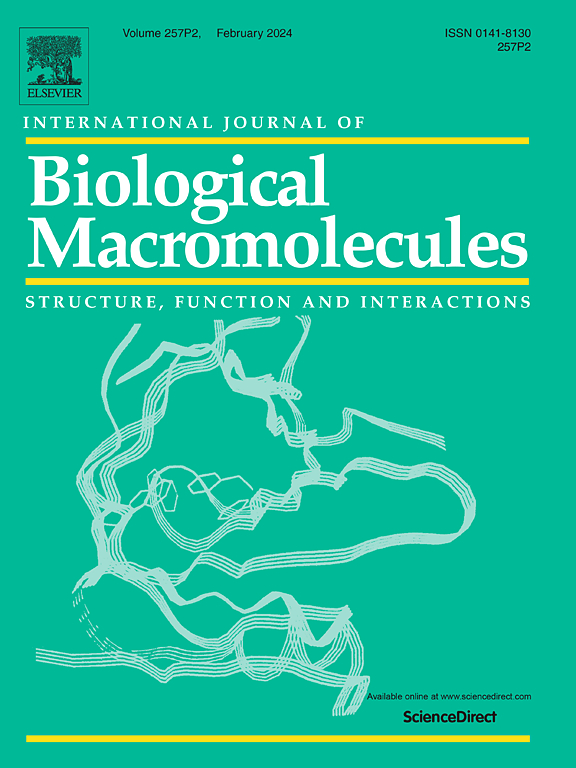HPMC/NaAlg-CuO 生物纳米复合材料的开发与表征:增强可持续包装应用的光学、电学和抗菌性能。
IF 7.7
1区 化学
Q1 BIOCHEMISTRY & MOLECULAR BIOLOGY
International Journal of Biological Macromolecules
Pub Date : 2024-12-01
DOI:10.1016/j.ijbiomac.2024.137774
引用次数: 0
摘要
通过浇铸法将氧化铜纳米颗粒(CuO NP)加入羟丙基纤维素(HPMC)和海藻酸钠(NaAlg)基质中,制成生物纳米复合薄膜。XRD 分析证实了 HPMC/NaAlg 基质的半晶体性质,在 2θ = 21.22° 处有一个宽峰,随着 CuO 浓度的增加,该峰的强度降低,表明其向无定形结构转变。傅立叶变换红外分析表明带强度发生了变化,这可能是由于在有 CuO 纳米填料的情况下聚合物混合物的体积分数降低了。SEM 图像显示,CuO NP 浓度较低时,混合物结构均匀,但当 CuO 浓度达到 0.9 wt% 时,纳米粒子聚集现象变得明显。紫外-可见光谱显示出从 212 纳米到 246 纳米的红移,光学能隙从纯混合物的 4.78 eV 下降到 0.9 wt% CuO 时的 2.99 eV,这与局部缺陷态增加有关。交流导电性和介电特性随着 CuO 的分散而得到改善,从而提高了生物纳米复合材料在电化学和光电应用中的适用性。生物纳米复合材料具有显著的抗菌活性,其中含 0.4 和 0.7 wt% CuO 的薄膜对枯草杆菌、金黄色葡萄球菌、铜绿假单胞菌和大肠杆菌的抑制面积最大。总之,这些研究结果表明,HPMC/NaAlg-CuO 生物纳米复合材料有望用于抗菌包装和光电子领域。本文章由计算机程序翻译,如有差异,请以英文原文为准。
Development and characterization of HPMC/NaAlg-CuO bio-nanocomposites: Enhanced optical, electrical, and antibacterial properties for sustainable packaging applications
Copper oxide nanoparticles (CuO NP) were incorporated into a hydroxypropyl cellulose (HPMC) and sodium alginate (NaAlg) matrix through a casting method to create bio-nanocomposite films. XRD analysis confirmed the semi-crystalline nature of the HPMC/NaAlg matrix, with a broad peak at 2θ = 21.22°, which decreased in intensity as CuO concentration increased, indicating a shift towards an amorphous structure. FT-IR analysis demonstrated changes in band intensity, which can be attributed to the reduced volume fraction of the polymer blend in the presence of the CuO nanofiller. SEM images showed homogeneity at low CuO NP concentrations, but at 0.9 wt% CuO, nanoparticle aggregation became evident. The UV–visible spectra indicated a redshift from 212 nm to 246 nm and a decrease in optical energy gap from 4.78 eV for the pure blend to 2.99 eV at 0.9 wt% CuO, associated with increased localized defect states. AC electrical conductivity and dielectric properties improved with CuO dispersion, enhancing the bio-nanocomposite's suitability for electrochemical and optoelectronic applications. The bio-nanocomposites demonstrated significant antibacterial activity, with films containing 0.4 and 0.7 wt% CuO achieving the largest inhibition zones against B. subtilis, S. aureus, P. aeruginosa, and E. coli. Overall, these findings suggest that HPMC/NaAlg-CuO bio-nanocomposites are promising candidates for use in antibacterial packaging and optoelectronics.
求助全文
通过发布文献求助,成功后即可免费获取论文全文。
去求助
来源期刊
CiteScore
13.70
自引率
9.80%
发文量
2728
审稿时长
64 days
期刊介绍:
The International Journal of Biological Macromolecules is a well-established international journal dedicated to research on the chemical and biological aspects of natural macromolecules. Focusing on proteins, macromolecular carbohydrates, glycoproteins, proteoglycans, lignins, biological poly-acids, and nucleic acids, the journal presents the latest findings in molecular structure, properties, biological activities, interactions, modifications, and functional properties. Papers must offer new and novel insights, encompassing related model systems, structural conformational studies, theoretical developments, and analytical techniques. Each paper is required to primarily focus on at least one named biological macromolecule, reflected in the title, abstract, and text.

 求助内容:
求助内容: 应助结果提醒方式:
应助结果提醒方式:


